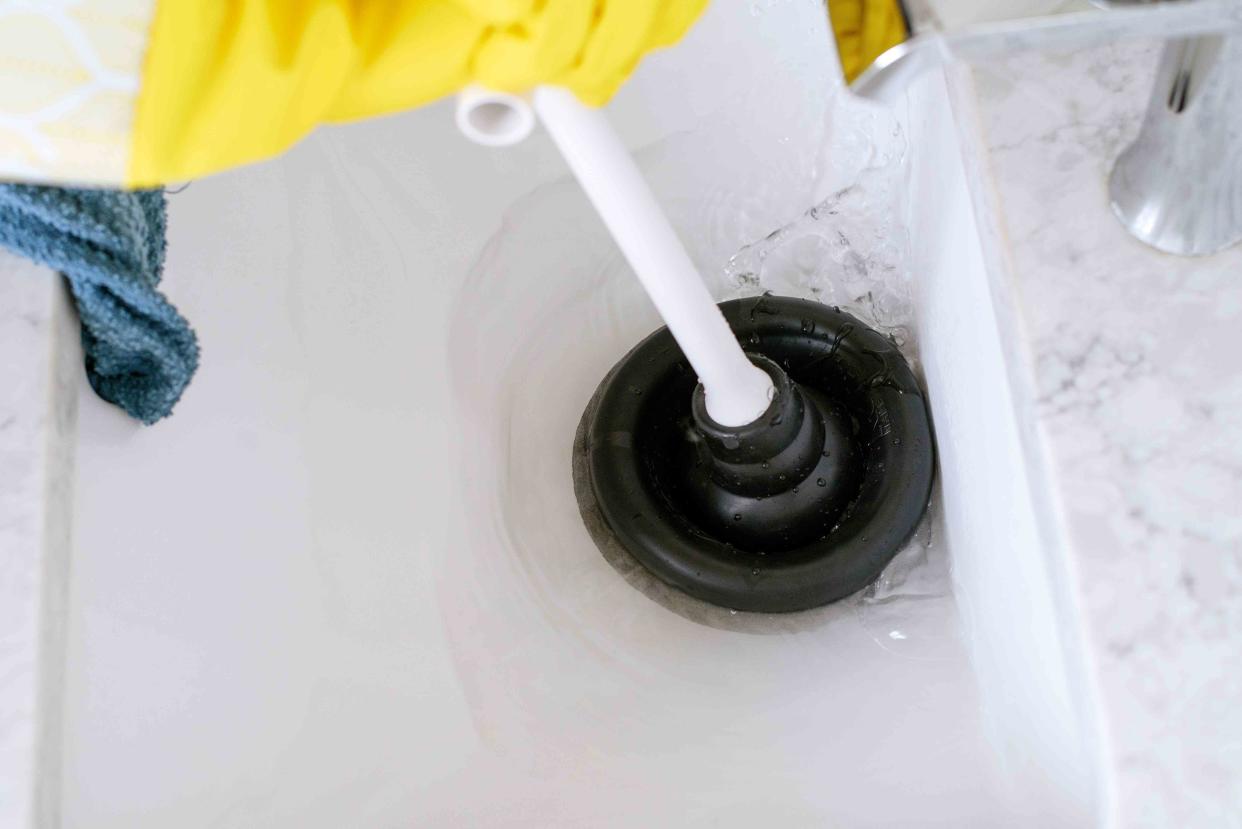How to Unclog a Kitchen Sink in 4 Easy Ways

The Spruce / Sarah Lee
Kitchen sink clogs are major annoyances that prevent you from using an important part of your kitchen. Thankfully, there are plenty of easy ways to unclog your sink that don't use harsh chemicals (or require calling a plumber!). Here are four ways to get started on getting rid of that drain clog.
Use Boiling Water
When dealing with kitchen sink clogs, boiling water can be a helpful first step to take. As boiling water will do little to rid your drain of grease or non-water soluble clogs, it's the least effective of these options, but it's also the easiest—so consider at least giving it a shot.
Heat a kettle (or large pot with a spout) of water until it boils.
Slowly pour the boiling water into the drain. A slow pour is key here—dumping the water in all at once will do little to dissolve a clog.
Run tap water down your drain to see if the clog is gone. If it's not, consider giving it one more pass with boiling water, or move on to another kitchen sink clog removal method.
Try Baking Soda and Vinegar
Vinegar has so many cleaning uses in the home—including drains! When paired with baking soda, the two create a chemical reaction that can remove mineral buildup in your sink drain. However, baking soda and vinegar cannot dissolve physical clogs, like hair or large pieces of food, so use another clog removal method if those items are the source of your drainage issues.
Flush your drain first by letting hot water from the sink run down the drain for a minute or two.
Pour one cup of baking soda down your drain.
Add one cup of vinegar to your drain, and prepare to hear lots of fizzing as the baking soda and vinegar react.
Run your sink for 30 seconds to see if your sink is properly draining yet. If it's not, repeat steps two and three again. If it is, run hot water down your drain for another two to three minutes to ensure any clog or buildup is fully flushed away.
Tip
If baking soda and vinegar are doing little to get rid of clogs in your drain, try replacing the vinegar with salt—after pouring one cup of baking soda down the drain, follow it with 1/2 cup of salt. Let both sit overnight in the drain, then flush with two cups of hot water.
Use a Plunger
A plunger can be used in more than just the bathroom! When used atop a kitchen sink drain, the plunger creates a vacuum effect, (hopefully!) loosening the clog and allowing it to be flushed away with water.
Cover any overflow drains or additional drains in your sink with a wet rag or a sink stopper—this ensures the plunger can form a seal.
Place the plunger on top of your drain and add enough water to submerge the bottom of the plunger.
Thrust the plunger up and down six or seven times, then remove the plunger to see if the sink water successfully drains away.
If the water drains, your clog has been loosened—hooray. Turn on your sink and let hot water run down the drain for two to three minutes to fully flush it away. If the water stays put, repeat steps two and three or try another clog removal method.
Clean the P-Trap and Use a Drain Snake
The p-trap of your sink is a great spot for clogs to hide, and a quick clean of it could be all your kitchen sink needs. If your p-trap is free and clear, your clog is likely further down your pipes—in that case, it's time to break out the drain snake.
Disconnect the p-trap from the sink pipes with the help of a pipe wrench. Place a small bowl or bucket underneath it so that any water still in the p-trap goes into the bucket, not onto your cabinets.
Look inside the p-trap to check for clogs. If you see one, put on some rubber gloves and pull it out, then rinse the p-trap out with hot water before connecting back to the sink pipes.
If the p-trap is empty, the clog is most likely further down the line. Grab your drain snake and begin feeding it down the pipes that go into the wall.
Once you feel resistance, your drain snake has found the clog. Push and pull the drain snake to break the clog, then slowly pull it back out according to its manufacturer's instructions.
Dispose of the clog and clean up any mess the drain snake has left behind.
Reattach the p-trap, then run hot water down the drain to flush away anything that's leftover in your pipes.
How to Prevent Kitchen Sink Clogs
Dealing with kitchen sink clogs can be a frustrating and messy way to spend the afternoon. But you can prevent most clogs from ever happening by following these tips.
Don't flush food down your drain unless you've got a garbage disposal.
Don't pour grease down the drain! Pour it into a small dish instead, where it can harden or cool down, then be disposed of in the trash.
Use a mesh drain basket to prevent small bits of food and grime from getting into your drains.
Rinse your drain with hot water after each use of the sink for dishes or cleaning. This ensures grime is flushed away, rather than left to harden and clog.
Read Next: How to Unclog Any Drain
Read the original article on The Spruce.

